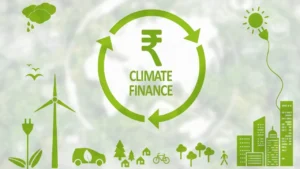GS3 – Environment

Context:
The Ministry of Finance released India’s draft Climate Finance Taxonomy. Its effectiveness as a governance instrument depends on establishing a structured review system.
About the Taxonomy:
- Serves as a classification system identifying economic activities as sustainable investments.
- Guides investors towards climate-friendly projects, curbs greenwashing, and enhances investor confidence.
- Designed as a “living document,” evolving with India’s climate priorities and international commitments.
Need for the Taxonomy:
- Global Alignment: Major economies have established taxonomies; India’s absence limited access to international climate finance.
- Uniform Criteria: Lack of standard definitions hindered consistent climate finance flows, accounting for only ~3% of FDI.
- Greenwashing Risks: Unverified sustainability claims misallocated funds and weakened global trust.
- Goal Orientation: Necessary to channel private finance to achieve Net Zero by 2070 and the vision of Viksit Bharat by 2047.
- Inclusive Finance: Ensures MSMEs and vulnerable communities are not excluded from climate financing.
Review Framework for Effectiveness:
- Global Alignment: Utilize review mechanisms under Article 6.4 of the Paris Agreement for international coherence.
- Two-Tier System: Short-term adaptability combined with long-term stability.
- Annual Reviews: Identify gaps, obligations, and stakeholder feedback with public consultation.
- Five-Year Comprehensive Review: Aligns with Nationally Determined Contributions (NDCs) and the UNFCCC global stocktake.
- Legal Coherence: Ensure integration with the Environment Protection Act, SEBI regulations, carbon credit rules, and fiscal instruments.
Accountability: DEA-based expert committee to publish review outcomes using dashboards for transparency.




